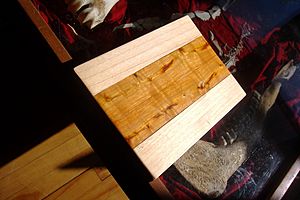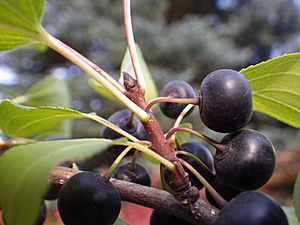European buckthorn facts for kids
Quick facts for kids European buckthorn |
|
|---|---|
 |
|
| Scientific classification | |
| Genus: |
Rhamnus
|
| Species: |
cathartica
|
| Synonyms | |
|
Cervispina cathartica (L.) Moench |
|
The European buckthorn, also known as common buckthorn or Rhamnus cathartica, is a type of small tree or shrub. It belongs to the flowering plant family called Rhamnaceae. This plant originally comes from Europe, northwest Africa, and western Asia. You can find it from the British Isles all the way to Morocco and Kyrgyzstan.
In the early 1800s, people brought European buckthorn to North America. They used it as a decorative plant in gardens. Now, it has spread widely across the northern part of the continent. It is considered an invasive plant in many parts of the United States and Canada. This means it can cause harm to local ecosystems.
Contents
What is European Buckthorn?
The European buckthorn is a deciduous shrub or small tree. This means it loses its leaves in the autumn. It can grow up to 10 meters (about 33 feet) tall. Its bark is grey-brown, and its branches often have thorns.
Leaves and Flowers
The leaves of the buckthorn are oval-shaped. They are usually between 2.5 to 9 centimeters (1 to 3.5 inches) long. They are green during spring and summer, then turn yellow in the autumn. The leaves grow in pairs or sometimes in an alternating pattern along the branches.
Buckthorn plants have yellowish-green flowers with four petals. These flowers are pollinated by insects. The plant is dioecious, which means male and female flowers grow on separate plants.
Fruits and Seeds
The fruit of the buckthorn is a round, black drupe. It is about 6 to 10 millimeters (0.2 to 0.4 inches) wide. Each fruit contains two to four seeds. Birds often eat these fruits, which helps spread the seeds through their droppings.
The plant's scientific name, cathartica, and its common name, purging buckthorn, refer to its strong laxative effect. This is because of certain chemicals found in the plant.
Why is European Buckthorn Harmful?
The seeds and leaves of the European buckthorn are mildly poisonous to humans and most animals. If eaten, they can cause stomach cramps and act as a laxative. This effect comes from chemicals like anthraquinone and emodin found in the plant.
In 1994, this plant was thought to be involved in a strange illness in horses. However, scientists never officially found a direct link. Studies on rodents showed that eating buckthorn leaves and stems could affect how their bodies store energy. This led to problems with their liver cells.
How Does Buckthorn Affect Nature?
European buckthorn can grow well even in shady areas. It grows moderately fast and does not live for a very long time. It is a food source for the brimstone butterfly. If you see these bright yellow butterflies, it might mean buckthorn or a similar plant is nearby.
Buckthorn is also a host plant for some diseases and pests. For example, it helps a rust disease called Puccinia coronata that affects cereal crops. It is also the main plant where soybean aphids spend the winter in North America. These aphids are a big problem for soybean farms.
Plant Chemicals and Soil
The buckthorn plant produces special chemicals, especially emodin, in its fruits, leaves, and bark. These chemicals might help protect it from insects, animals, and diseases. Emodin is found more in unripe fruits. This might stop birds from eating them too early, allowing the seeds to fully develop before they are spread. Birds and mice tend to avoid unripe fruits. If they do eat them, they might get sick or have loose stools.
Buckthorn also releases chemicals from its leaves, roots, and bark into the soil. These chemicals can stop other plants from growing nearby. This is called allelopathy. Soils where buckthorn grows often have more nitrogen and carbon. This makes dead leaves break down faster, creating bare patches of soil. Buckthorn grows very well in these disturbed areas, which helps its seeds sprout easily.
An Invasive Plant
In North America, European buckthorn is an invasive plant. It has a big advantage over native trees and shrubs. It competes with their roots for nutrients and water. It also creates a lot of shade. Plus, buckthorn leaves grow earlier in the spring than most native plants. This means it can start making food through photosynthesis before other plants even have their leaves.
Forests with a lot of buckthorn often have soil with higher nitrogen levels, higher pH (meaning it's less acidic), and more water. This is because buckthorn leaves contain a lot of nitrogen and break down quickly.
Buckthorn is also linked to invasive European earthworms in the northern Midwest of North America. When buckthorn is removed, the number of these invasive earthworms decreases by about 50%. These earthworms, along with the extra nitrogen from buckthorn leaves, can harm North American forests. They break down leaf litter too quickly, destroying helpful fungi that many native trees need to grow. This leaves bare soil, which is perfect for buckthorn seeds but bad for native plants.
You can find common buckthorn in most northern US states, especially around the Great Lakes in Minnesota, Wisconsin, and Michigan. Birds help spread its seeds, but only certain bird species are good at spreading them effectively. Buckthorn can survive cold winters. Some US states, like Minnesota, Connecticut, Iowa, Massachusetts, New Hampshire, and Vermont, have laws against importing, selling, or growing this plant because it is a harmful noxious weed.
How to Control Buckthorn

Controlling European buckthorn is hard because it grows back strongly from its roots after being cut or burned. One popular and effective way to control it is to apply herbicides to freshly cut stumps. However, buckthorn seeds can stay alive in the soil for several years. This means you need to treat the area many times and keep checking it for new sprouts.
Chemicals like Garlon and Tordon work well. Glyphosate (Roundup) can also be used but is less reliable. Applying these chemicals in early winter is best. At this time, most native plants are dormant, so there's less risk of harming them. It's also easier to spot buckthorn plants in winter because their leaves stay green much longer than native plants, sometimes up to 58 days longer.
Other ways to control buckthorn include pulling out young plants or chopping them down. These methods are better for the environment but take a lot of time. Small plants (less than 1 meter or 3 feet tall) can be pulled easily. However, pulling them might disturb the roots of nearby native plants. You can also use propane weed-torches to kill young buckthorn seedlings. If burned in spring or early summer, they usually won't grow back.
Uses of Buckthorn
Historically, the bark and fruit of Rhamnus cathartica were used in traditional medicine as a strong laxative. The wood of the buckthorn is hard and dense. The bark can also be used to make a dye.
See also
 In Spanish: Espino cerval para niños
In Spanish: Espino cerval para niños


